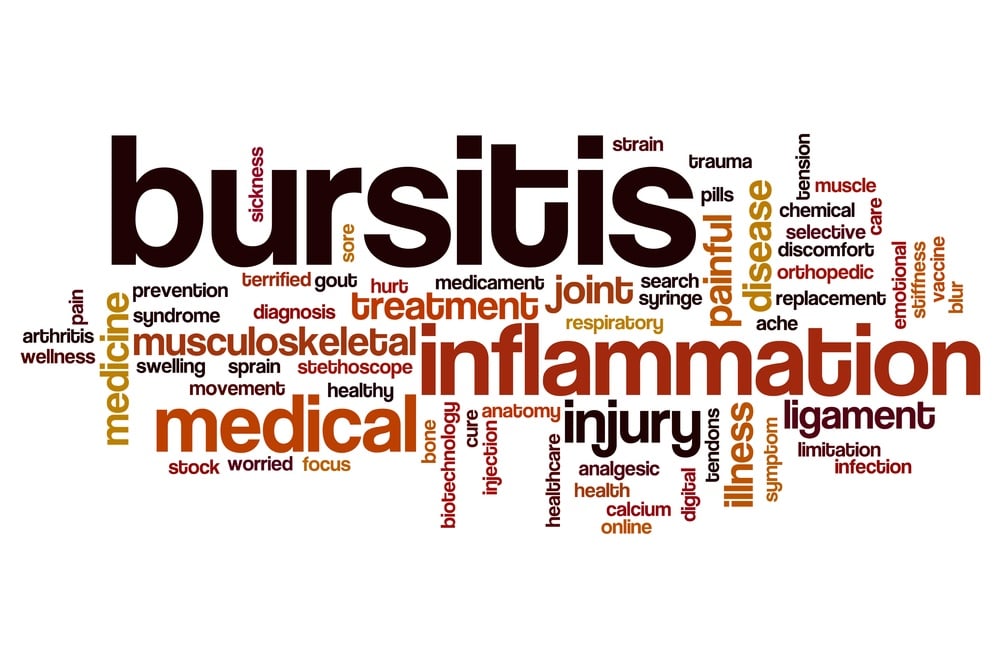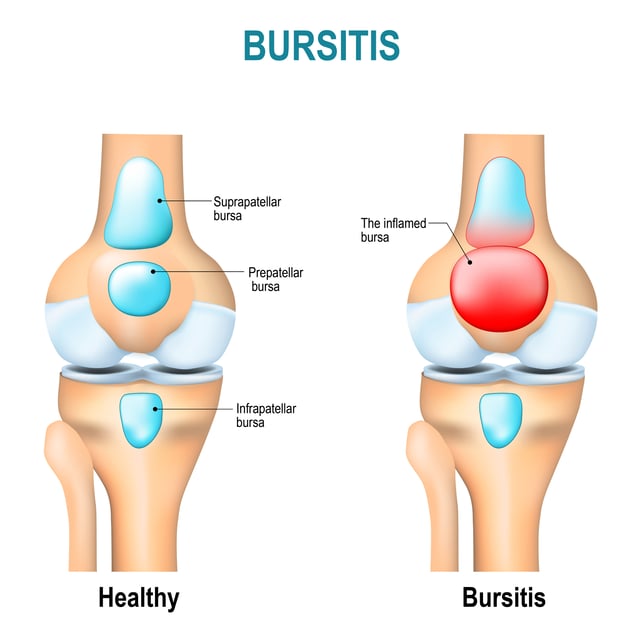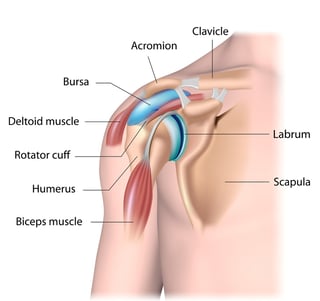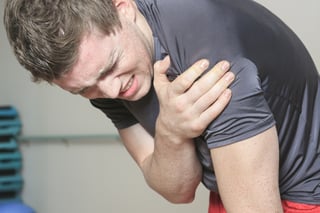Bursitis: What Is It, Causes, and Areas of the Body Affected
April 4th, 2017 | 3 min. read

If you’re feeling sharp intense pain — or a dull ache — that spreads outward from a single point in your joints, it’s possible you have a condition called bursitis, an inflammation of the bursa (plural, bursae).
What Are Bursae?
 Bursae are fluid-filled sacs (or sac-like cavities) that exist to protect bones, tendons, and ligaments. They are lined with a connective tissue called the synovial membrane and they contain a lubricating substance called synovial fluid, which provides cushioning.
Bursae are fluid-filled sacs (or sac-like cavities) that exist to protect bones, tendons, and ligaments. They are lined with a connective tissue called the synovial membrane and they contain a lubricating substance called synovial fluid, which provides cushioning.
Bursae are found throughout the body in places where tissue and bone routinely rub up against each other. A few such places include:
- Shoulder
- Elbow
- Hip
- Knee
- Heel
 Bursae are also found in areas where a point or protuberance could create friction, like in the acromion of the shoulder joint. The acromion is the bony point at the upper and outer part of the shoulder, where the collarbone (clavicle) and the deltoid muscles attach. The ball and socket joint of the shoulder is positioned directly below this bony overhang. A length of tendon is also present between these parts, connecting muscle to bone.
Bursae are also found in areas where a point or protuberance could create friction, like in the acromion of the shoulder joint. The acromion is the bony point at the upper and outer part of the shoulder, where the collarbone (clavicle) and the deltoid muscles attach. The ball and socket joint of the shoulder is positioned directly below this bony overhang. A length of tendon is also present between these parts, connecting muscle to bone.
Several components of the shoulder share a compact space. Add to this the regular movements of the joint when you raise your arm or swing it around or across your body. Tissue and bone move over and past each other dozens or hundreds of times per day.
Fortunately, the fluid-filled subacromial bursa lies between the acromion and the tendon, creating a cushioned space that enables these parts to glide past one another. In mechanical terms, this bursa is like WD-40 for the shoulder joint.
What Is Bursitis (and What Are its Symptoms)?
When the bursa become irritated, inflamed, or infected, fluid buildup inside the sac can enlarge it, causing pain and increased friction — meaning mobility may be more difficult than usual.
The main symptoms of bursitis are:
- Bursitis pain can be sudden and sharp or aching and diffuse. For some people, the pain is worse at night and is exacerbated by pressure (for example, hip bursitis can feel worse after sitting in a chair for too long, or lying on one’s side in bed for several hours).
- Loss of motion. Depending on the severity and location of your bursitis, you may have difficulty moving the affected area. For example, shoulder bursitis can lead to “frozen shoulder,” a slowly-developing condition where the shoulder becomes stiff and painful and its range of motion becomes severely curtailed. Of course, immobility could have other causes, like fracture, impingement, dislocation, or a tendon or cartilage tear. If you have pain and immobility in any part of your body, you’ll need to see a doctor to confirm a diagnosis and treatment plan.
What Causes Bursitis?

Bursitis is an inflammatory condition with many possible causes. It’s usually brought on by injury, but age is often a factor.
Sometimes, it’s caused by anatomy — some people may have slight irregularities in the formation of their bones that can lead to rubbing and irritation.
Common reasons people get bursitis include:
- Repetitive strain. Any movement you do or position you hold over and over again, or for a sustained period of time, can lead to an irritated bursa. Examples:
- Minor impact injury. A modest blow to the area where a bursa is located can lead to irritation and inflammation. For example, if you bang your funny bone on something hard, you may inflame the olecranon bursa, the flat disc that cushions the bony point of the elbow.
- Acute injury. A sudden fall or impact injury can inflame the bursa. This is a common cause of hip bursitis. Tears and ruptures of tendons and ligaments, which usually cause swelling, can also contribute.
- Slight anatomical deviations or changes in posture can lead to bursitis; for example, if one leg is shorter than the other, the change in your gait may create a misalignment that leads to rubbing and irritation.
- Some bursae that are close to the surface of your skin (for example, the elbow bursa) can become infected through cuts or scrapes. Most people can fight off these infections; those with weakened immune systems are more at risk.
- Stress from other health conditions. Bursitis can develop in response to other problems in the body that may be affecting the function of the joints. Arthritis (OA or rheumatoid), gout, certain autoimmune conditions, diabetes, and reactions to medications have all been shown to increase one’s risk of developing bursitis. Bone spurs can also contribute to irritation.
- Sometimes, the placement of artificial implants and prosthetics — for example, in the hip, knee, or shoulder — can irritate or inflame the bursa.
- Age (over 40). As with many orthopedic issues, getting older is a contributor.
High-Risk Activities and Sports
Overuse is one of the most common causes of bursitis, especially if you’re over 40. You’re also more likely to develop it if you have poor posture, are in poor physical condition, or don’t stretch regularly.
The following are activities associated with bursitis.
Housework and hobbies
- Gardening (the kneeling is rough on the knees)

- Household work (carpentry/sanding, house painting, plumbing, scrubbing floors)
- Playing musical instruments (string instruments especially, as they involve repeated motions of the shoulder, elbow, and wrist)
- Yard work (raking, shoveling)
Sports
- Cycling
- Golf
- Racquet sports (tennis, racquetball)
- Running
- Skiing
- Throwing sports (baseball/softball, football, javelin)
Where Bursitis Occurs in the Body
You can develop bursitis anywhere the bursae are located:
Upper body
- Elbow
- Shoulder
- Wrist
Lower body
- Achilles tendon/heel area
- Ankle
- Hip
- Knee
Bursitis can be painful and it may limit your activities while you’re experiencing it. The good news is, it’s treatable. The first step is to see an orthopedic physician for an exam and diagnosis.
After your doctor confirms your condition, he or she will make a recommendation as to the best way to treat your symptoms and get you back to normal.
Article written by: Rob Williams, MD
Dr. Williams has been practicing orthopedic surgery in Corpus Christi since 1998. After graduating from Texas Tech hereceived his medical degree from the University of Texas at San Antonio. At the prestigious Campbell Clinic located at the University of Tennessee, Dr. Williams completed not only an Orthopedic Surgery Residency, but an additional year of Fellowship Training in Spine Surgery. Dr. Williams is dedicated to creating an excellent patient experience in the office or in the surgery suite.
Topics:


